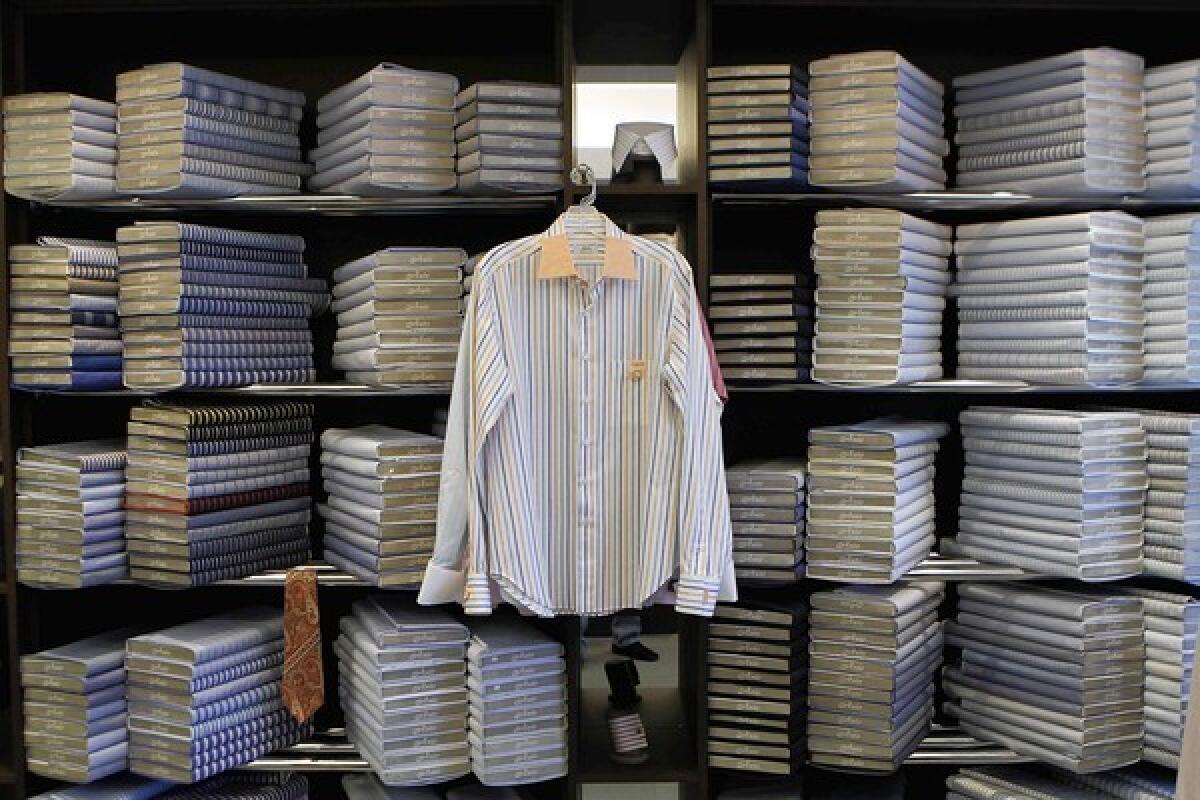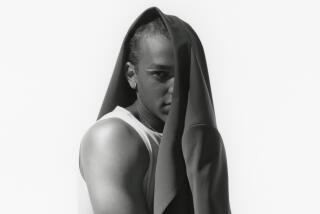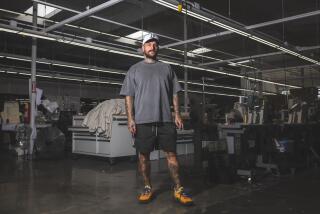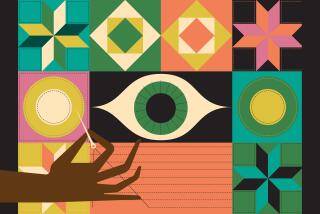Custom shirts, cut from a different cloth

Custom-made men’s dress shirts were once considered the privileged peacockery of the moneyed set — a dash of sartorial swagger that could be afforded only by Hollywood A-listers, Wall Street bankers and monocle-wearing aristocrats of a bygone era.
But today, thanks to advances in technology, a competitive market and consumer demand, custom clothing has moved within the barrel-cuffed arm’s reach of the common man. Click a button in Burbank and a factory in Beijing can cut and sew a dress shirt made to specification — not just in size, shape and fabric, but with a mind-boggling number of other options as well (including mitered pockets, contrasting buttonholes, French cuffs and rounded collar points). And it can be delivered to your doorstep in less than three weeks for the sum of $100 — less than half the price of an off-the-peg luxury brand using the same high-end Italian fabrics.
FOR THE RECORD:
Custom shirts: In the Jan. 29 Image section, an article about custom-made men’s dress shirts said that clothier J.Hilburn takes six measurements when fitting a dress shirt. Ten measurements are taken. —
That’s the business model of 5-year-old, Dallas-based custom clothier J.Hilburn, which couples e-commerce with a nationwide direct-sales team of “style advisors” armed with fabric swatches and tape measures who do initial in-person consultations. The company has gone from selling $1 million worth of custom dress shirts in 2008 to more than 10 times that last year, according to co-founder Veeral Rathod. “We sold 100,000 custom dress shirts in 2011,” Rathod said. “Up from 60,000 in 2010.”
J.Hilburn isn’t the only crafter of custom shirts to report growth. Peter Crawfurd, the co-founder and chief executive of 3-year-old website ShirtsMyWay.com, declined to provide specific figures, but he said 2011 sales were up 91% over 2010. A similar online purveyor, Indochino (which also sells custom men’s suits and outerwear), has seen sales triple over the last three years, according to its co-founder and chief executive, Kyle Vucko.
Even some in the old-school bricks-and-mortar custom shirt business — such as Anto Distinctive Shirtmaker in Beverly Hills, where the shirts cost $325 each, require at least two fittings and are made no further afield than Sherman Oaks — report a bump in business.
“Knock on wood, we’ve seen sales increasing every year,” said Jack Sepetjian, a partner with his brother Ken in the family business named for their father. “The last five or six years we’ve noticed more of the younger guys — in their 30s and 40s — coming in. That’s a good sign for us.”
Although it doesn’t track custom dress shirts specifically, market research firm NPD Group reports that sales in the men’s dress shirt category jumped 13.49% to $2.78 billion in the 12-month period ending Nov. 30 (compared with a 2.26% increase in the overall men’s shirt and sweater business in the same period).
Paulo Goncalves, a partner and co-designer of New York City-based ready-to-wear label Bespoken Clothiers, which rolled out a Web-based made-to-measure program in October, explained why the brand decided to enter an increasingly crowded arena.
“We’re living in a world where people are customizing everything from their cars to their computers to their phones and the skins on their phones,” Goncalves said. “But it’s been really slow to translate to clothing. We figured that if we could do it — in the proper manner — it’d be a good opportunity.”
Bespoken’s idea of the “proper manner” helps illustrate how the custom shirt business has changed since the days when the words “custom shirt” meant one thing: a truly handmade garment, cut from a pattern made specifically for a single individual (the way Anto’s still does today) for which the customer could specify any number of details.
At Bespoken’s website, for $245 a customer can specify fabric, collar and cuff style, enter four measurements (collar, chest, waist and sleeve) and three weeks later receive a shirt featuring Thomas Mason fabric that’s been handmade in the same U.K. factory that makes shirts for venerable British clothier Turnbull & Asser.
“There’s storytelling that goes along with it as well,” Goncalves said. “It takes 16 people to construct a single shirt, we use only mother-of-pearl buttons, and the shirts are all made in the same factory that made the famous James Bond shirts. Someone who wants made-to-measure wants a story to go along with it, something they can sit in a bar and talk to their mates about.”
If you’re working with a clothing budget that’s more “savings” than “story,” websites like the aforementioned ShirtsMyWay (starting at $75) or Indochino ($79 and up) exchange pedigree for price tag, offering shirts in less expensive fabrics and made in Asia instead of England.
But in reality, none of these options is truly “custom” in the strictest sense of the word. A custom garment is based on an individual pattern made from scratch, while these newer options are made-to-measure — based on a standard, existing shirt pattern which is then sized up or down to fit.
“If you’re paying $125 to $225 for a shirt and you’re going by four or five measurements, that’s fine, that’s understandable,” said Anto’s Jack Sepetjian, who says his shop has more than 10,300 patterns on file. “But the more measurements you take, the better a shirt’s going to fit. We take over 21 different measurements — six different measurements for the collar itself — to build each person an individual pattern based on their exact posture down to the sixteenth of an inch. If they are going through that process, then that’s a perfect custom shirt.”
That brings us back to J.Hilburn’s hybrid approach, which is neither as cold and impersonal as the straight e-tail model nor as expansive and expensive as a traditional tailor such as Anto. Every prospective customer is required to meet with a style advisor at least once (after that orders can be placed online). It’s not just for a detailed measuring (six for a dress shirt) but also to rifle through closets looking for favorite shirts, discuss preferences and talk over the myriad options (four options for the button placket alone) before placing an initial order for a shirt priced from $89 to $159, depending on fabric and details.
Studio City resident Chip Meehan, a J.Hilburn customer for the last year and a half, says having a style advisor has not only been helpful, it’s made the shopping experience enjoyable. “There were questions asked to which I guess I had an opinion, but I hadn’t formulated it,” he said. “For example, I prefer the button-down collars where the button is hidden underneath. When I was asked if I’d like that I was like: ‘Why yes, I would!’”
He works in sales at Comcast, so the 56-year-old Meehan isn’t required to dress up on a daily basis. “But when I do, it’s nice to have something that fits me better — there’s not fabric in the wrong place and things aren’t short where they should be longer. I used to wear traditional shirts that were so blousy I felt like I could have had other people in there with me. Now, it’s not like I get a flood of comments, but I’ve definitely had people ask me if I’ve lost weight or say things like I seem more fit.”
Meehan says he orders about four times a year. “Usually for the change of the season,” he said. “Think I’ll try some casual shirts next. I see a time when two-thirds of my closet is filled with custom stuff.”
Rathod says that average customer spending has been increasing by about $200 a year. And in addition to helping create a lucrative and long-lasting customer relationship, style advisors serve another practical purpose — keeping custom shirt remakes down to, in his words, “a phenomenally low 3%.”
“I can see the younger guys, who are maybe a little more fashion-forward, trying to take their own measurements, giving it a shot online, maybe looking for the best price,” he said. “But our guy is a 45-year-old professional — a doctor, lawyer or banker, and he appreciates this concierge-type service.”







